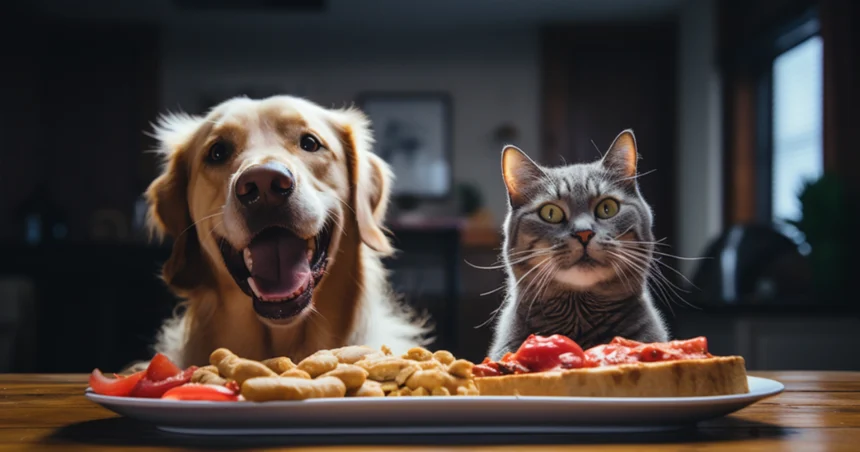Many cat owners have experienced the frustration of finding their feline companion sneaking bites of the dog’s food. While it may seem harmless, there are important reasons why cats and dogs have very different dietary needs. Cats are obligate carnivores and require a high protein, meat-based diet. Dogs are omnivores and can tolerate more carbohydrates and plant material. Feeding a cat dog food can lead to serious health issues over time due to the nutritional imbalance. Understanding why cats shouldn’t eat dog food and how to stop the behavior is key for any multi-pet household.
Why It’s Important for Cats Not to Eat Dog Food
Cats and dogs have very different nutritional needs. Cats are obligate carnivores, meaning they thrive on meat-based diets and have limited ability to digest plant material. Dogs, on the other hand, are omnivores and can get nutrients from a wider variety of foods.
This key difference is why it’s important to stop cats from eating dog food. The most significant issue is protein content. Cat foods have 2-3 times more protein than dog foods. Dry dog foods only contain about 18-25% protein, while cat foods contain a minimum of 36-40% protein. Cats need this high protein level to meet their metabolic demands.
Eating dog food long-term can cause serious health issues for cats:
- Insufficient protein leads to muscle wasting and unhealthy weight loss over time.
- Higher carbs raise the risk of obesity, diabetes, and urinary problems.
- Low taurine can harm heart and eye health. Taurine is an essential amino acid for cats but typically deficient in dog foods.
- Low calcium in dog food can also cause issues for cats.
While the occasional nibble of dog food won’t necessarily harm an otherwise healthy cat, regular long-term consumption provides inappropriate nutrition levels. Cat-specific formulas are tailored to cats’ unique dietary needs as obligate carnivores.
Tips & Tricks to Prevent Cats from Eating Dog Food
Discovering your cat’s sneaky ventures into the dog’s bowl can be amusing, but as we’ve seen, it’s essential to curb this behavior for their well-being. Here are some strategies and recommendations to ensure your cat sticks to their designated diet.
Limit Access to Dog Food
Understanding the cat’s crafty nature means being a step ahead. One simple solution? Avoid free-feeding. Instead of leaving dog food out all day, try to stick to specific meal times. This way, you reduce the window of opportunity for your feline friend to indulge. Also, it’s a good habit to remove any uneaten dog food after 10-15 minutes. Not only does this prevent the cat from snacking on it, but it also promotes a healthier eating routine for your dog.
Scheduled Dog Feeding Times
Consistency is key. By establishing routine and timed feeding for your dog, you create a predictable environment. Your cat will gradually learn these feeding times and is less likely to be around the dog’s bowl. A simple trick? Call your dog for meals. This ensures your canine friend consumes their food promptly, leaving no leftovers for the cat to pounce on.
Innovative Ways to Protect Dog Food
Cats might be agile, but a few adjustments can make it challenging for them to access the dog food. Elevated platforms or raised dog bowls can deter most cats. Another useful tip is to store the dog food in sealed containers. This not only keeps the food fresh but also restricts the enticing aroma, which might attract your cat.
Separate Feeding Areas
A bit of spatial organization can go a long way. Designate specific feeding zones for your pets. For instance, feed the cat in the kitchen and the dog in the living room. This spatial separation makes it less likely for your cat to venture into the dog’s territory during meal times.
The Cat Meal Box Solution
Think outside the box, or rather, think of a box. Repurposing a covered litter pan as a feeding station for your cat is ingenious. The design ensures your larger canine companion can’t access it, while your cat can enjoy their meals in peace. Just ensure it’s distinctly separate from their actual litter box!
Training and Discipline
While cats are known for their independent nature, they can be trained. With patience and consistency, employ training techniques to discourage food theft. Start with simple voice commands, like ‘No’, when you catch them in the act. Always be gentle; it’s about redirection, not punishment. Supervision during the initial training periods is essential to reinforce this new behavior.
Conclusion
Ensuring your pets receive species-appropriate nutrition tailored to their unique needs is one of the foundations of being a responsible pet owner. While it may seem harmless to let your cat snack on dog food, the nutritional imbalances can accumulate over time and lead to serious health consequences.
Cats require very high protein levels and other nutrients like taurine to thrive, which dog food simply does not provide. Facilitating bad eating habits also risks conditioning your cat to develop an unhealthy fixation on forbidden food. With some planning and training, it is possible to stop cats from eating dog food.
By keeping dog food out of reach, separating feeding areas, establishing set meal times, and discouraging food-stealing behaviors, you can feel confident your pets are both getting optimal nutrition. Your cat will be healthier in the long run without the unnecessary calories and improper protein-to-carb ratios of dog food. A little effort goes a long way in preventing bad habits and keeping your furry companions happy and well-fed on diet plans suited just for them.


